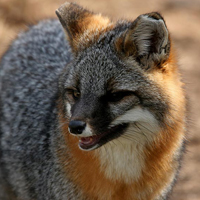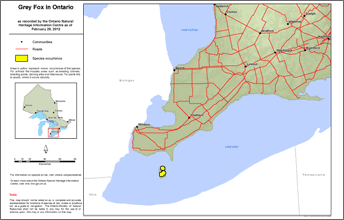Gray fox
Scientific name: Urocyon cinereoargenteus

Cover photo credit: JD Taylor
Status
Threatened
"Threatened" means the species lives in the wild in Ontario, is not endangered, but is likely to become endangered if steps are not taken to address factors threatening it.
Date added to the Species at Risk in Ontario List
The Gray Fox was already assessed as threatened when the Endangered Species Act took effect in 2008. A reassessment in June 2016 confirmed this status.
Read the assessment report (PDF)
What it looks like
The Grey Fox is the size of a small dog and looks very similar to the familiar Red Fox. But unlike the Red Fox, the Grey Fox has grizzled grey fur with lighter cinnamon coloured patches on its body. It also has a black tail tip, while the Red Fox has a white tail tip. The Grey Fox has shorter legs and a smaller snout than the Red Fox, and it can have a very long bushy tail.
Where it lives
In Ontario, the Grey Fox lives in deciduous forests and marshes. Grey Fox dens are usually found in dense shrubs close to a water source but they will also use rocky areas, hollow trees, and underground burrows dug by other animals. This species will live in many types of habitat provided there is sufficient shelter and prey availability.
Where it’s been found in Ontario
The range of the Grey Fox extends across much of the United States, where it is relatively common. In Canada, it is found only in Ontario and Manitoba. In Ontario, its historic range is across the southernmost portions of the province.
In recent years, this range has been reduced to west of Lake Superior in the Rainy River District and on Pelee Island in west Lake Erie. There have been occasional sightings and reports of the Grey Fox close to the U.S. border in the Niagara, Thousand Islands and Windsor areas.
View a larger version of this map (PDF)
What threatens it
The Grey Fox is typically found in warmer climates. In Canada, harsh winters could be preventing it from moving northward.
Action we are taking
Threatened species and their general habitat are automatically protected.
Recovery strategy
A recovery strategy advises the ministry on ways to ensure healthy numbers of the species return to Ontario.
Read the executive summary and the full document (July 22, 2019)
Government response statement
A government response statement outlines the actions the government intends to take or support to help recover the species.
Read the government response statement (April 23, 2020)
Habitat protection
General habitat protection - June 30, 2013
What you can do
Report a Sighting
- Report a sighting of an endangered animal or plant to the Natural Heritage Information Centre. Photographs with specific locations or mapping coordinates are always helpful.
Volunteer
- Volunteer with your local nature club or provincial park to participate in surveys or stewardship work focused on species at risk.
Be a good steward
- Private land owners have a very important role to play in species recovery. You may be eligible for stewardship programs that support the protection and recovery of species at risk and their habitats.
Report illegal activity
- Report any illegal activity related to plants and wildlife to
1-877-847-7667 .
Quick facts
- Grey Foxes can climb trees! They use their sharp, hooked claws to scramble up tree trunks and can even jump from branch to branch.
- Grey Fox tracks look very similar to a domestic house cat. But, unlike a cat, fox prints always have claw marks.
- The Grey Fox is not a picky eater. Small rodents and rabbits are the preferred food during the winter, but this omnivore will also eat apples, corn, and wild grapes in the summer and fall.
